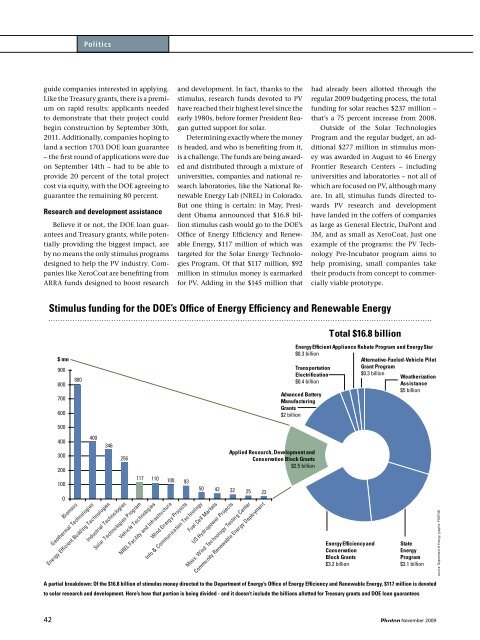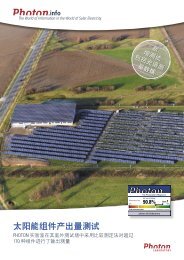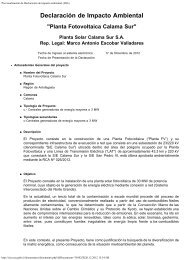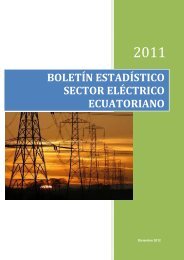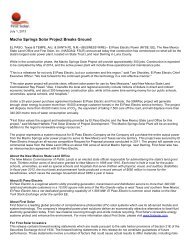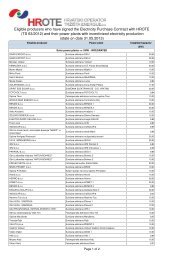INTRODUCTORY SPECIAL INTRODUCTORY ... - PHOTON Info
INTRODUCTORY SPECIAL INTRODUCTORY ... - PHOTON Info
INTRODUCTORY SPECIAL INTRODUCTORY ... - PHOTON Info
You also want an ePaper? Increase the reach of your titles
YUMPU automatically turns print PDFs into web optimized ePapers that Google loves.
42<br />
Politics<br />
guide companies interested in applying.<br />
Like the Treasury grants, there is a premi-<br />
um on rapid results: applicants needed<br />
to demonstrate that their project could<br />
begin construction by September 30th,<br />
2011. Additionally, companies hoping to<br />
land a section 1703 DOE loan guarantee<br />
– the first round of applications were due<br />
on September 14th – had to be able to<br />
provide 20 percent of the total project<br />
cost via equity, with the DOE agreeing to<br />
guarantee the remaining 80 percent.<br />
Research and development assistance<br />
Believe it or not, the DOE loan guar-<br />
antees and Treasury grants, while poten-<br />
tially providing the biggest impact, are<br />
by no means the only stimulus programs<br />
designed to help the PV industry. Com-<br />
panies like XeroCoat are benefiting from<br />
ARRA funds designed to boost research<br />
Stimulus funding for the DOE’s Office of Energy Efficiency and Renewable Energy<br />
$ mn<br />
900<br />
800<br />
700<br />
600<br />
500<br />
400<br />
300<br />
200<br />
100<br />
0<br />
800<br />
400<br />
346<br />
Biomass<br />
Geothermal Technologies<br />
Energy Efficient Building Technologies<br />
256<br />
Industrial Technologies<br />
Solar Technologies Program<br />
117 110 100 93<br />
Wind Energy Projects<br />
Vehicle Technologies<br />
NREL Facility and Infrastructure<br />
<strong>Info</strong> & Communication Technology<br />
and development. In fact, thanks to the<br />
stimulus, research funds devoted to PV<br />
have reached their highest level since the<br />
early 1980s, before former President Rea-<br />
gan gutted support for solar.<br />
Determining exactly where the money<br />
is headed, and who is benefiting from it,<br />
is a challenge. The funds are being award-<br />
ed and distributed through a mixture of<br />
universities, companies and national re-<br />
search laboratories, like the National Re-<br />
newable Energy Lab (NREL) in Colorado.<br />
But one thing is certain: in May, Presi-<br />
dent Obama announced that $16.8 bil-<br />
lion stimulus cash would go to the DOE’s<br />
Office of Energy Efficiency and Renew-<br />
able Energy, $117 million of which was<br />
targeted for the Solar Energy Technolo-<br />
gies Program. Of that $117 million, $92<br />
million in stimulus money is earmarked<br />
for PV. Adding in the $145 million that<br />
50 42 32 25 22<br />
Fuel Cell Markets<br />
US Hydropower Projects<br />
Mass. Wind Technology Testing Center<br />
Community Renewable Energy Deployment<br />
Energy Efficient Appliance Rebate Program and Energy Star<br />
$0.3 billion<br />
Alternative-Fueled-Vehicle Pilot<br />
Transportation<br />
Electrification<br />
$0.4 billion<br />
Advanced Battery<br />
Manufacturing<br />
Grants<br />
$2 billion<br />
Applied Research, Development and<br />
Conservation Block Grants<br />
$2.5 billion<br />
had already been allotted through the<br />
regular 2009 budgeting process, the total<br />
funding for solar reaches $237 million –<br />
that’s a 75 percent increase from 2008.<br />
Outside of the Solar Technologies<br />
Program and the regular budget, an ad-<br />
ditional $277 million in stimulus mon-<br />
ey was awarded in August to 46 Energy<br />
Frontier Research Centers – including<br />
universities and laboratories – not all of<br />
which are focused on PV, although many<br />
are. In all, stimulus funds directed to-<br />
wards PV research and development<br />
have landed in the coffers of companies<br />
as large as General Electric, DuPont and<br />
3M, and as small as XeroCoat. Just one<br />
example of the programs: the PV Tech-<br />
nology Pre-Incubator program aims to<br />
help promising, small companies take<br />
their products from concept to commer-<br />
cially viable prototype.<br />
Total $16.8 billion<br />
Energy Efficiency and<br />
Conservation<br />
Block Grants<br />
$3.2 billion<br />
Grant Program<br />
$0.3 billion<br />
Weatherization<br />
Assistance<br />
$5 billion<br />
State<br />
Energy<br />
Program<br />
$3.1 billion<br />
A partial breakdown: Of the $16.8 billion of stimulus money directed to the Department of Energy’s Office of Energy Efficiency and Renewable Energy, $117 million is devoted<br />
to solar research and development. Here’s how that portion is being divided - and it doesn’t include the billions allotted for Treasury grants and DOE loan guarantees<br />
November 2009<br />
source: Department of Energy, graphic: <strong>PHOTON</strong>


